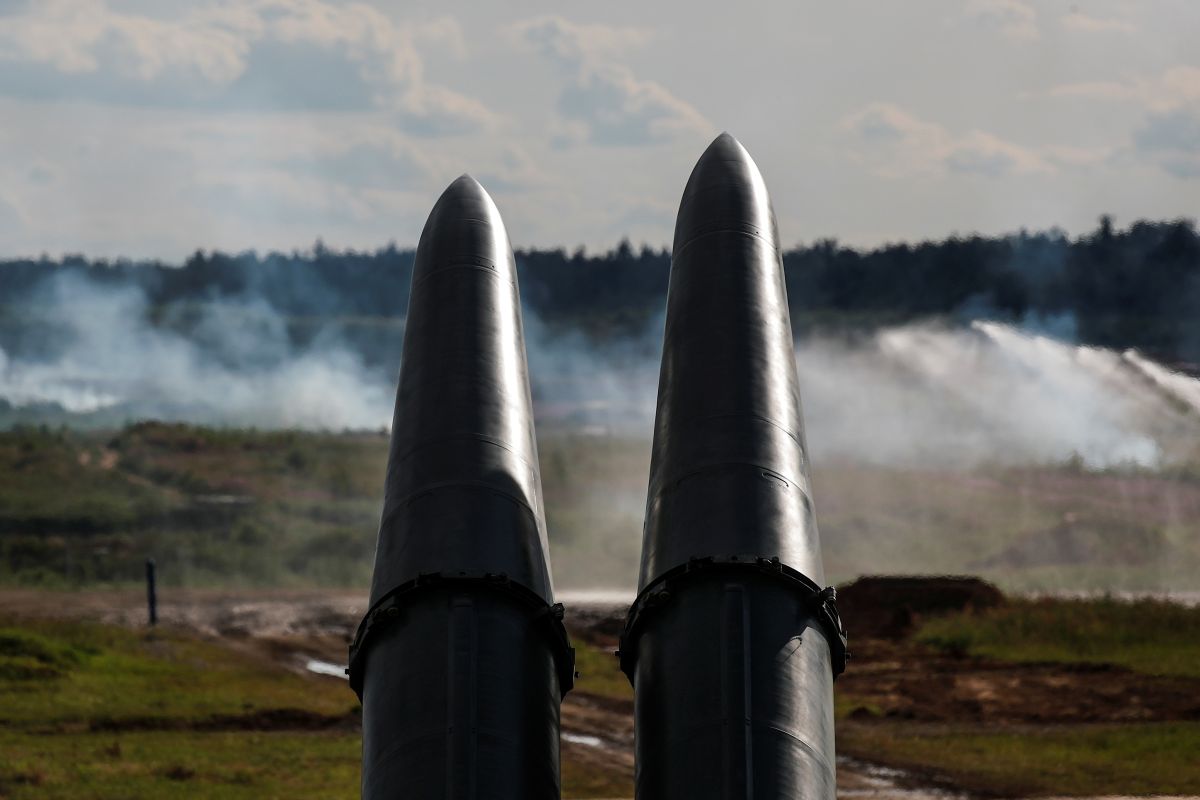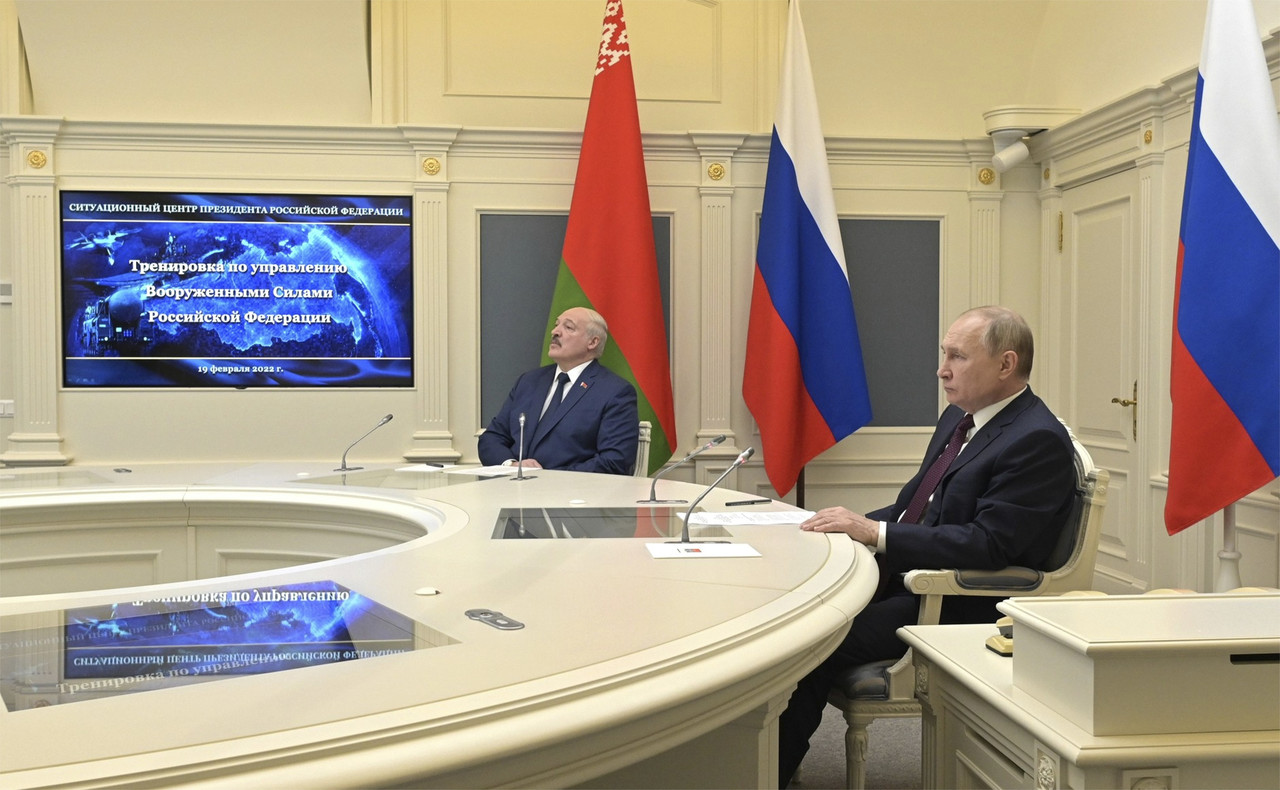Russia Sharpens Nuclear Signalling Towards NATO
Russia has stepped up attempts to intimidate NATO with nuclear weapons, mainly by preparing for their deployment in Belarus. Russia wants to coerce the Alliance’s members into limiting their support for Ukraine. NATO countries should demonstrate more strongly that they will not be intimidated, also to reduce the risk that Russia, if faced with a collapse of its forces, will opt for a nuclear strike against Ukraine. In addition to renewing their warnings to Russia, the Alliance’s members should start discussing how to expand NATO’s nuclear capabilities in Europe.
(1).jpg) Vasily Fedosenko / Reuters / Forum
Vasily Fedosenko / Reuters / Forum
On 9 June, Vladimir Putin announced that preparations of special storage facilities in Belarus, which he announced in March, would be completed on 7-8 July and that the deployment of nuclear warheads to these areas would begin afterwards. On 16 June, however, he claimed that Russia had already placed the first of the weapons in Belarus and would deploy the rest by the end of this summer or by the end of the year. NATO reported that it had only noticed “some preparations” in this regard.
Russia presents the deployment of nuclear weapons in Belarus as a response to calls from Alexander Lukashenka and the strengthening of NATO’s military posture, especially on its Eastern Flank. It also cites the presence of U.S. nuclear bombs in several Alliance countries under nuclear-sharing agreements as a pretext. Analogous to the NATO concept, nuclear warheads in Belarus are to remain under the control of Russia, which may allow their use by Belarussian forces. Russia has provided Belarus with the capabilities to do so over the last year by transferring Iskander missile launchers, modifying some Belarussian SU-25 close-air support aircraft, and training the crews of both systems.
At the same time, Russia is clearly linking the nuclear deployment in Belarus to Western support for Ukraine. On 16 June, Putin described the stationing of the weapons as an element of deterrence for states seeking to inflict a “strategic defeat” on Russia. He also spoke of readiness to use nuclear weapons in the event of a threat to Russia’s integrity and sovereignty, while also declaring that he saw no need to do so now. Meanwhile, calls for a stronger “reminder” that further support for Ukraine may lead to nuclear war with Russia are coming from commentators close to the Kremlin. Some have even advocated for a limited nuclear strike on Poland or other European NATO states, claiming that the U.S. would be afraid to respond with a nuclear attack on Russia.
Increase in Nuclear Signalling
Russia is again trying to coerce the West into weakening its support for Ukraine. However, the deployment of nuclear weapons in Belarus is the first major change in the Russian nuclear forces’ posture since the start of the full-scale invasion. Until recently, Russia’s nuclear threats involved mostly rhetoric. Intensification of this signalling began with Russia suspending the New START treaty with the U.S. (which limits intercontinental nuclear forces) in February.
The increase in nuclear pressure is linked to the failure of Russia’s winter offensive, the start of the Ukrainian counter-offensive, and the growing scope of arms supplies to Ukraine (including talks on the delivery of Western combat aircraft). Russia may also be trying to impede discussions before the Alliance’s summit in Vilnius on 11-12 July, especially on granting Ukraine security guarantees, including shortening its path to NATO. It is unclear, however, whether the increase in nuclear signalling is a desperate attempt to exert influence in the absence of other options or the result of a belief that the West is vulnerable to nuclear threats, but which have been too weak so far. Russian leadership may think they were still partially successful and prevented NATO military intervention and delayed the transfer of certain weapons. Some NATO leaders, including the U.S. and Germany, have publicly linked limitations on aid to Ukraine to fears of escalation.
Russia will continue to publicise the progress in deploying nuclear weapons to Belarus (although it is questionable whether they are already there). It may also further escalate its threats, especially in the event of major Ukrainian successes on the battlefield. Russia’s options include conducting a nuclear test on its territory and/or preparing for a potential attack by raising the readiness of its nuclear forces, including transferring warheads to launchers and aircraft. Both during the war against Ukraine and after its potential conclusion, Russia may also lower its official threshold for nuclear use, begin work on new nuclear delivery systems, and deploy more nuclear forces near the border with NATO. Given the weakening of Russian conventional forces due to the war in Ukraine, an even greater role of nuclear weapons in Russian policy and doctrine is to be expected.
Implications for Poland and NATO
The deployment of nuclear weapons in Belarus, at the border with NATO states, is primarily intended to demonstrate Russia’s readiness to use them rapidly in a conflict with the Alliance. Even if Belarusian forces are the ones to carry out such an attack, they would do so only with the consent of Russia, which would share responsibility for it. Carrying out a nuclear strike against NATO in retaliation for arms deliveries to Ukraine would, however, run counter to Russia’s efforts to date to deter military intervention by NATO states in the war. Allied intervention would undoubtedly tip the balance of the conflict in Ukraine’s favour. Moreover, even in case of a limited nuclear strike against NATO, Russia would face a serious risk of U.S. retaliation and nuclear escalation, as has been rightly pointed out by many Russian experts who have criticised calls for such an attack.
There is a larger risk that, if faced with a collapse of the Russian military (especially the prospect of losing Crimea), Russia could decide to launch a nuclear attack on Ukraine in an attempt to break its will to fight or to physically stop Ukrainian forces. This risk will increase if Russia concludes that, through nuclear threats, it can deter the U.S. and its allies from even a conventional response to a nuclear attack on Ukraine. Moreover, if Russia believes that its threats will force a decrease in military aid to Ukraine over time, this will reinforce Russian resolve to continue fighting. Depending on how the war ends, Russia may also conclude that nuclear weapons helped it win or avoid defeat, and this would increase the danger that it would attack NATO under the cover of nuclear threats in a more distant future.
In military terms, the deployment of nuclear weapons and their means of delivery to Belarus broaden Russian options for a nuclear attack on NATO’s Eastern Flank, although it will not fundamentally change the balance of forces. Russia already has significant capabilities to conduct such strikes from the main part of its territory, the sea, air, and from the Kaliningrad Oblast. The additional Iskander missiles increase the chances that Russia could penetrate NATO air defences and attack more targets (the obsolete SU-25s have little combat value). Belarus is likely to receive at least a brigade of these missiles. This will increase the possibility of strikes on Poland, which is already within range of a Russian Iskander brigade from Kaliningrad, and allow Iskanders to reach parts of Czechia, Slovakia, Romania, Hungary, and western Ukraine. It should be noted, however, that Russia has a total of 13 Iskander brigades and could deploy at least some of these launchers and nuclear warheads to Belarus during or before a conflict with NATO anyway.
Recommendations
NATO countries should demonstrate their resilience to nuclear threats more clearly. Not only should the members—especially the U.S.—remind Russia that any use of nuclear weapons will have catastrophic consequences for it. The Alliance should also start discussing how to expand its nuclear capabilities in Europe. This could include broadening Allied participation in nuclear sharing (as already called for by Poland), and/or developing and deploying new nuclear weapons delivery systems. The very initiation of such a debate would send a clear signal to Russia that NATO is determined to respond to nuclear escalation. In addition, the Alliance should better adapt its capabilities to the challenges and threats that could weaken the credibility of deterrence in the longer term. The growth of the Chinese nuclear and conventional forces increases the danger that, in the event of a U.S.-China conflict, the availability of U.S.-based bombers will be reduced despite being an important option for a proportionate response to a limited nuclear attack on NATO. Russia, in turn, may strengthen its capability to rapidly attack NATO’s relatively small nuclear forces in Europe over the nearest decade.
Starting such a discussion will not be an easy step for NATO countries. Many believe that the ongoing modernisation of nuclear forces is sufficient to maintain deterrence and that talks on expanding them will be too alarmist and make it easier for Russia to divide NATO members and intimidate their populations. The greater danger, however, is that Russia will see the lack of a strong response as a sign of weakness and will again—as with the decision to invade Ukraine in 2022 —underestimate the Alliance’s resolve and seek to drag out and escalate the war against Ukraine. While any use of nuclear weapons would be very risky for Russia, it is in Poland’s interest to strengthen NATO nuclear deterrence as much as possible. Due to its location, Poland would be particularly exposed to consequences of a failure of deterrence.





.jpg)